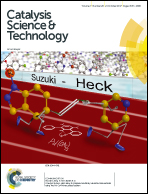Alkanethiolate-capped palladium nanoparticles for selective catalytic hydrogenation of dienes and trienes†
Abstract
Selective hydrogenation of dienes and trienes is an important process in the pharmaceutical and chemical industries. Our group previously reported that the thiosulfate protocol using a sodium S-alkylthiosulfate ligand could generate catalytically active Pd nanoparticles (PdNP) capped with a lower density of alkanethiolate ligands. This homogeneously soluble PdNP catalyst offers several advantages such as little contamination via Pd leaching and easy separation and recycling. In addition, the high activity of PdNP allows the reactions to be completed under mild conditions, at room temperature and atmospheric pressure. Herein, a PdNP catalyst capped with octanethiolate ligands (C8 PdNP) is investigated for the selective hydrogenation of conjugated dienes into monoenes. The strong influence of the thiolate ligands on the chemical and electronic properties of the Pd surface is confirmed by mechanistic studies and highly selective catalysis results. The studies also suggest two major routes for the conjugated diene hydrogenation: the 1,2-addition and 1,4-addition of hydrogen. The selectivity between two mono-hydrogenation products is controlled by the steric interaction of substrates and the thermodynamic stability of products. The catalytic hydrogenation of trienes also results in the almost quantitative formation of mono-hydrogenation products, the isolated dienes, from both ocimene and myrcene.



 Please wait while we load your content...
Please wait while we load your content...